February 12, 2016
Air Date: February 12, 2016
FULL SHOW
SEGMENTS

High Court Puts Clean Power Plan On Hold
View the page for this story
The Supreme Court has issued a stay on implementation of the Obama Administration’s Clean Power Plan. This could delay mandatory emissions cuts from the electric power sector. But other legal options that were strengthened by the Paris Climate Agreement might be better suited for tackling climate change domestically and internationally. Vermont Law School Professor Pat Parenteau and host Steve Curwood discuss the stay and its affect on the President’s strategy for tackling climate change. (08:40)

Beyond the Headlines
/ Peter DykstraView the page for this story
In this week’s trip beyond the headlines, Peter Dykstra and host Steve Curwood talk about a college committing to 100 percent solar power and an effort to open up buried streams in Detroit, Michigan. Also, they remember a 1950s television personality who vividly predicted the impacts of climate change and sea-level rise. (04:00)

Sierra Snows Ease, But Won't End California Drought
/ Emmett FitzGeraldView the page for this story
Californians hope two months of plenty of snow could ease the 4-year drought. But Living on Earth’s Emmett Fitzgerald reports that high snowfalls in the Sierra Mountains this winter won’t end the water problems and the state needs to manage the resource creatively and efficiently for the foreseeable future. (08:55)

Sex and Sustainability in the Sea
View the page for this story
The extensive ecosystem under the waves depends on the intricate, complex and mysterious mating rituals of its inhabitants. Host Steve Curwood speaks with Marah Hardt, a marine biologist and author of a new book, Sex in the Sea about some clever and unusual reproductive strategies unique to sea-dwellers and why understanding this is critical for maintaining the resource. They then discuss how lobsters communicate their readiness to mate, how some whales try to ensure their genes will persist, and how static corals in reefs manage to make more corals, and Hardt argues that success in their various methods are vital for sustainable fisheries. (25:00)
Show Credits and Funders
Show Transcript
HOST: Steve Curwood
GUESTS: Pat Parenteau, Marah Hardt
REPORTERS: Emmett Fitzgerald, Peter Dykstra
[THEME]
CURWOOD: From Public Radio International, this is Living on Earth.
[THEME]
CURWOOD: I'm Steve Curwood. A major part of President Obama’s strategy to cut global warming gases is the Clean Power plan that pushes states to axe coal-fired electricity. But now the Supreme Court has put that plan on hold.
PARENTEAU: For those states that are still somewhat on the fence - and of course there are a number - this is a signal that basically says you can slow down, you don't have to keep working hard on developing your plans, so this is an ominous sign, I think, for EPA.
CURWOOD: Also, with Valentine’s Day in mind, we look under the waves at nature’s way of ensuring a healthy supply of seafood, and how it can grab public attention.
HARDT: If you talk about sex, people are curious and maybe, there's a way that you can talk about sex, draw their attention and then subtly weave in the message of conservation because ultimately, successful sex is the heart of sustainability.
CURWOOD: Sex and more this week, on Living on Earth. Stick around.
[NEWSBREAK MUSIC: Boards Of Canada “Zoetrope” from “In A Beautiful Place Out In The Country” (Warp Records 2000)]
ANNOUNCER: Support for Living on Earth comes from United Technologies – innovating to make the world a better, more sustainable, place to live.
[THEME]
High Court Puts Clean Power Plan On Hold

The EPA’s Clean Power Plan rules, if allowed to go forward, would require states to limit carbon dioxide emissions from coal-fired power plants. (Photo: Matthew D. Wilson, Wikimedia Commons CC BY-SA 2.5)
CURWOOD: From the Jennifer and Ted Stanley studios at the University of Massachusetts Boston and PRI, this is Living on Earth. I’m Steve Curwood. By a five-to-four decision, the US Supreme Court has temporarily put a hold on the implementation of the Obama Administration’s Clean Power Plan. More than two dozen states plus some utilities and coal producers had asked the high court to freeze the operation of the rule. The court’s action is seen as a setback for a key part of the Obama Administration’s climate action plans. This decision likely means the next president will decide how to implement the Clean Power plan if it does eventually survive the appeals. To unweave this complicated legal web, we turn to Vermont Law School Professor Pat Parenteau. Welcome to the program, Pat.
PARENTEAU: Thanks, Steve.
CURWOOD: So, first of all, what exactly has the Supreme Court done in issuing a stay here?
PARENTEAU: Well they put a hold on the Clean Power Plan pending a decision first by the DC Circuit Court of Appeals which has the case in front of it right now, then depending on what happens after the DC circuit issues its ruling, the stay of the rule could remain in effect until the Supreme Court has made a final decision in the case. This assumes that they ultimately will agree to review it, which seems like a reasonable assumption at this point.
CURWOOD: So what was the basis of issuing this stay pending appeal?
PARENTEAU: Well, it was a one-page order agreed to by five of the justices of the Supreme Court with four dissenters, Justice Breyer, Justice Kagan, Justice Ginsburg and Justice Sotomayor, but the order itself contains no analysis, no explanation for why the five members of the court felt like a stay was necessary, and usually in these kinds of cases you have to show extreme harm and prejudice that's happening immediately for a court to issue a stay. That really isn't the case here. The Clean Power Plan is going to take many years for it to be implemented. In fact, the very first compliance deadlines under the Clean Power Plan don't kick in until 2022, so this is very unusual what the court has done here.
CURWOOD: Now, but would some of the states that have objected to this say, look, it may be a while before we have to implement this, but power plants take a long time to construct and deconstruct. We don't want people putting tremendous amounts of money into making this change if for some reason it's going to get knocked out down the road.
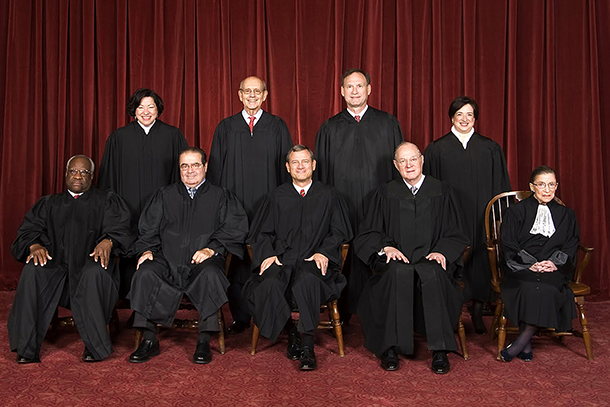
The Supreme Court of the United States, pictured in 2010. Top row (left to right): Justices Sonia Sotomayor, Stephen G. Breyer, Samuel A. Alito, and Elana Kagan. Bottom row (left to right): Justices Clarence Thomas and Antonin Scalia, Chief Justice John G. Roberts, and Justices Anthony Kennedy and Ruth Bader Ginsburg. (Photo: Steve Petteway, CC government work)
PARENTEAU: Yes, that is the argument and, that probably did influence the justices to agree to the stay, but, of course, the response is that a lot of the planning that is currently underway is the kind of planning that states are already engaged in and in fact almost all of the states even the ones that are challenging the plan are proceeding quite diligently with these plans given the changes in the energy market that are occurring, given the fact that coal plants are closing down due to market forces even more so than environmental regulation, due to the fact that renewable energy sources are the fastest-growing sources not only in United States but around the world, so the kind of planning that the Clean Power Plan is requiring is the kind of planning that should be done anyway.
CURWOOD: Talk to me a little bit about the court action here. There were five votes in favor of this temporary hold. That would include Anthony Kennedy who voted in favor of finding that the EPA should regulate carbon dioxide as a dangerous pollutant way back when.
PARENTEAU: At this stage of the preceding, the stay is really supposed to be mainly focused on why is it necessary to call a halt to everything right now instead of letting the lower court hear these arguments which are scheduled to be heard in June. It's not like we have a long time to wait, so it's very unusual that even Justice Kennedy would agree to put a hold to everything, but it certainly is a troubling sign and it obviously...these five members of the court have serious questions about EPA's rule perhaps when they hear all of the facts and look at the record and listen to the arguments they can be persuaded that what EPA is doing is reasonable, but right now I think that the betting is that there is some serious obstacles ahead for EPA.
CURWOOD: What might those be?
PARENTEAU: Well this is the first time EPA has used this particular authority in the Clean Air Act to address energy planning across the country, and a lot of people see it as an overreach by EPA into areas that are traditionally handled by the states, that is, planning for electricity generation. EPA's response is, “We're using a traditional approach where we set goals and we leave it to the states to decide best how to reach them.”It's not all that different than we've done with other pollutants. If you think about lead or gasoline or mercury emissions, the difference of course is we're doing it on a much larger scale because the scale of the climate change problem is so great.

Pat Parenteau says the Supreme Court’s decision to impose a stay on the Clean Power Plan, without offering an explanation, is highly unusual. (Photo: Phil Roeder, Flickr CC BY 2.0)
CURWOOD: So this is a presidential election year. To what extent do you think the high courts issuance of this stay of this whole on the clean power plan is related to our electoral politics?
PARENTEAU: Well, certainly the presidential candidates on the Republican side of the aisle have all expressed opposition to the Clean Power Plan. You often hear some of the same talking points about how EPA has exceeded its authority and is violating the Clean Air Act and even running afoul of the Constitution. So the stay order, even though it doesn't contain any analysis that actually supports those allegations, the mere fact that the Supreme Court has done this will certainly be a talking point, I think, in the elections on both sides.
CURWOOD: Now, the Clean Power Plan was cited by the Obama Administration in the negotiations at the Paris climate summit. So what are the implications of this stay for the Paris agreement do you think?
PARENTEAU: I don't think it immediately impacts the commitments that have been made in the Paris agreement. Most of those commitments have to do with reporting greenhouse gas goals and monitoring those goals to see how they're being achieved. The Paris agreement reinforces the President's approach to using existing domestic authority.
CURWOOD: Now, we've recently talked to some folks that say that there are other clauses in the Clean Air Act, particularly something called Section 115 that would give justification for US administration to implement an economy wide program of reducing greenhouse gas, something even more comprehensive than the Clean Power Plan. Your views?
PARENTEAU: Yes, Section 115 has two requirements. One is a finding that emissions in the United States are causing endangerment and damage in other countries. That's not hard to show given the science of climate change. The second finding that triggers section 115 is this reciprocity provision which basically says the United States shouldn't be committing to doing things that other nations aren't prepared to similarly commit to and that's where the Paris agreement I think becomes absolutely central. We now have for the first time 196 nations of the world committing to doing at least something. The agreement gives EPA and gives United States the opportunity to say,“We're getting reciprocal commitments from these other nations to reduce their emissions.”And you're right, 115 might be a better approach to the problem.
CURWOOD: The morning after the Supreme Court order issuing a stay of the Clean Power Plan, a good day for folks who are in favor of climate action or a bad day?
PARENTEAU: It's a bad day. At a minimum, it's going to send a confusing signal to the states that are working on these plans, to the utilities that are working on the plans. So for those states that are still somewhat on the fence of course there are number this is a signal that basically says you can slow down, you don't have to keep working hard on developing your plans. That's not a good thing, that's delaying progress. We have a short window of time to reduce these emissions before we reach some really dangerous tipping points. On the other hand, as Yogi Bear likes to say, "It ain't over till it's over," and we still have an opportunity to argue in the DC circuit that the plan is reasonable and take that argument to the Supreme Court and hopefully with time and more study we can convince some of the members of the court that are currently skeptical about this plan that what EPA's doing is legal, lawful and necessary.
CURWOOD: Pat Parenteau is a law professor from Vermont Law School. Thanks so much Pat, for taking time with us today.
PARENTEAU: You're very welcome, Steve.
Related links:
- Read the states’ stay application
- More about Section 115 of the Clean Air Act
- Our conversation with EPA Administrator Gina McCarthy on the agency’s efforts to regulate carbon dioxide emissions
- About Pat Parenteau
- The Guardian: US clean power plan setback ‘will not affect Paris climate change deal’
- Inside Climate: Supreme Court Halts Clean Power Plan, with Implications Far Beyond the U.S.
- Commentary from Legal Planet: Initial Thoughts on the Supreme Court Staying the Clean Power Plan
- Washington Post Opinion: Placing the Clean Power Plan in context
Beyond the Headlines

Hampshire already had a reputation for being “green.” Now, the small liberal arts college is working to get 100% of its power from solar energy. (Photo: Jared and Corin, Flickr CC BY-SA 2.0)
CURWOOD: We’ll head beyond the headlines now with Peter Dykstra. Peter’s with the DailyClimate.org, and Environmental Health News – that’s EHN.org and joins us on the line from Conyers, Georgia. Hey, Peter, what’s on deck this week?
DYKSTRA: Hi, Steve. Some news from a small liberal arts school. Hampshire College in Massachusetts has pledged to become the first residential college to power itself with 100 percent solar energy.
CURWOOD: Yeah, it’s a non-traditional school, and as I understand it their football team has never lost a game since Hampshire College opened in 1970.
DYKSTRA: Yeah, that’s cause they don’t have a football team! You know down here in the south, that almost makes you not a college.
CURWOOD: Yeah well, hey, just how green is Hampshire?
DYKSTRA: They have a campus-wide sustainability initiative where they’ve cut water use, they’ve let the grass grow—they have meadows instead of mowed lawns, LED lighting and they’re planning to install thousands of solar panels.

The City of Detroit is hoping to open up streams that had been covered over by concrete years ago. (Photo: Mike Fritcher, Flickr CC BY-NC 2.0)
CURWOOD: How soon is this going to happen? What do they reckon it will cost and or save them?
DYKSTRA: It’ll take several years and one report put the price tag for all this at $11 million. They also have a lot of contributions from sustainability-minded businesses. There’s no really firm figure on what the system will ultimately save the school and its tuition paying students and parents.
CURWOOD: And how much is that tuition?
DYKSTRA: Well, the school’s website lists tuition, room and board at just over $60,000 a year.
CURWOOD: It’ll take a lot of solar cells to offset that.
DYKSTRA: Right.
(CLARIFICATION: After this segment was recorded Hampshire College contacted us to say they thought we had misrepresented their environmental initiatives by not mentioning their new campus center, constructed to the greenest building standards in the world, and that using 100% solar energy to power the school would save $340,000 each year.)
CURWOOD: What’s next?
DYKSTRA: A different water story from a different city in Michigan than the one we’ve been hearing about. It’s from my EHN colleague Brian Bienkowski.
There are 310 miles of streams in the city of Detroit have been buried – nearly every natural waterway in the city over the last century. It’s a system that never worked right, and engineers are trying to figure out ways to bring those streams back.
CURWOOD: But there’s no illusion that you’re actually going back to nature here?
DYKSTRA: No, it’s not back to nature for an inner city, but part of the way back is a big improvement.

A stream that has been “daylit” in Seoul, South Korea (Photo: Inhabitat, Flickr CC BY-NC-ND 2.0)
CURWOOD: Hmmm. Hey what do you have for us from the history calendar this week?
DYKSTRA: I have Dr. Frank Baxter. He’s a really fascinating guy from the 1950s, and like some politicians today who are fond of saying when they’re trying to duck a climate change question, Frank Baxter was Not A Scientist. But there’s a book, called Sonnets and Sunspots by Eric Niderost, recounting how this English Lit professor became “Doctor Research” in a series of 8 highly-produced 1950’s science documentaries on things like genetics, the human senses, the blood system, and more.
Four of the documentaries were directed by Hollywood legend Frank Capra. They lost money, but they drew millions of network TV viewers and played for a generation of school kids in classrooms.
CURWOOD: Kind of like Bill Nye.
DYKSTRA: Right, like Bill Nye but to a bigger, wider audience. The most remarkable thing: about Dr. Frank Baxter, he foretold climate change concerns nearly 59 years ago this week:
Here’s what he said, ”Man may be unwittingly changing…"
BAXTER: Man may be unwittingly changing the world's climate through the waste products of his civilization. Due to our release through factories and automobiles every year of more than 6 billion tons of carbon dioxide, which helps air absorb heat from the sun, our atmosphere seems to be getting warmer.
MAN: This is bad?
BAXTER: Well it’s been calculated a few degrees rise in the Earth’s temperature would melt the polar icecaps.
[DRAMATIC MUSIC ON THE FILM, SOUNDS OF CRASHING ICE]

In many ways, “Dr. Research” was a 1950s version of Bill Nye, helping to educate the general public about science. (Photo: Bear Manor Media)
BAXTER: And if this happens, an inland sea would fill a good portion of the Mississippi valley, tourists in glass-bottomed boats would be viewing the drowned towers of Miami through 150 feet of tropical water.
CURWOOD: Wow, Frank Baxter was really prescient. I mean if the ice sheet over Antarctica melts it would raise the oceans almost 200 feet!
DYKSTRA: That’s right and to me the moral of the story is this: we need more Frank Baxters if we want more science literacy in our country today.
CURWOOD: Indeed. Peter Dykstra is with Environmental Health News, that’s EHN.org and the DailyClimate.org. Thanks Peter, talk to you again soon.
DYKSTRA: OK, Steve, thanks a lot, we’ll talk to you soon.
CURWOOD: And there’s more on these stories at our website, LOE.org.
Related links:
- Hampshire College goes solar
- Detroit to Open Up its Streams
- More on “Daylighting” Streams in Cities
- More about environmental communicator and tv personality, Dr. Research
[MUSIC: Roswell Rudd and Heather Masse, Social Cal, August Love Song by Qusim Bashir/Jon Hendricks, Red House Records]
CURWOOD: Just ahead...measuring the snow in California’s Sierra Nevada. Stay tuned to Living on Earth.
[CUTAWAY MUSIC: Sultans Of String with Anwar Khurshid, A Heart Does What It Does, Subcontinental Drift, MCK Records]
Sierra Snows Ease, But Won't End California Drought
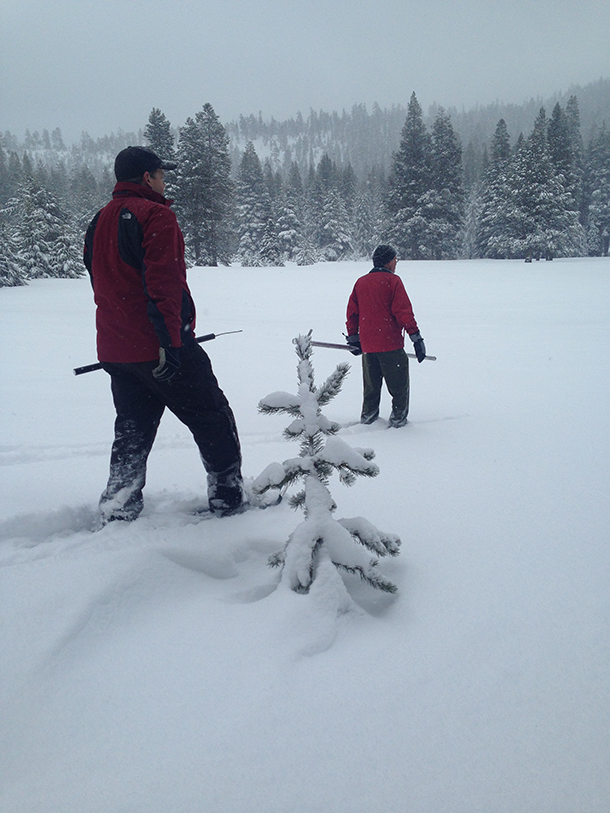
California Department of Water Resources employees ski to work at the Philips Station near Lake Tahoe. (Photo: Emmett FitzGerald)
CURWOOD: It’s Living on Earth, I’m Steve Curwood. This winter, the weather pattern known as El Niño has brought some much-needed rain to the parched California landscape. And even more importantly, the Sierra Nevada Mountains have gotten a lot of snow, which when it melts, should provide water to rivers and reservoirs come summer. The Sierra snowpack makes up 1/3 of California’s water supply - the rest comes from the winter storms - and many wonder if the heavy snows from December and January will provide relief from the long-standing drought. Living on Earth’s Emmett FitzGerald investigates.
[SOUNDS OF SKIING]
FITZGERALD: In green wool pants and a red jacket, Frank Gehrke skis across a snowy field at the Philips Station in the Sierra Mountains near Lake Tahoe. Frank's been doing snow pack assessments for the California Department of Water Resources for a long time.
GEHRKE: Let’s see I started in‘81 and then came up here to work for the state in‘87, so it’s been awhile.
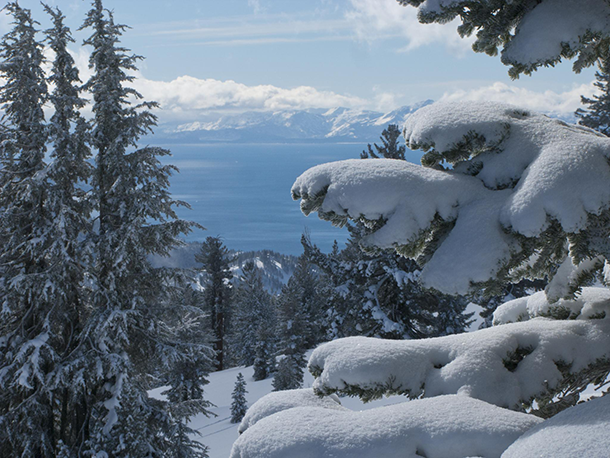
Snowy Lake Tahoe (Photo: Reno Tahoe, Flickr CC BY-NC-ND 2.0)
FITZGERALD: Frank’s carrying a giant metal tube as he skis. He stops in the center of the field and plunges it into the snow.
[SOUNDS OF THE STAKES GOING INTO SNOW: SOUNDS CONTINUE]
FITZGERALD: He measures both the depth and the weight of the snow-core in order to calculate how much water is in the snowpack.
GEHRKE: We’re basically taking a core sample of the snow, then we weigh that core, you know the weight of water is well known, so it turns out that the geometry of the tube is such that an ounce of weight represents an inch of water content.]
FITZGERALD: A Tahoe local named James E Church first developed this process way back in 1909.
GEHRKE: He was a professor of romance languages I believe. [LAUGHTER]
[SOUNDS OF THE STAKES GOING INTO SNOW CONTINUE]
FITZGERALD: Frank takes measurements at 7 different sites throughout the field, to account for any variability in the ground surface. He calls out numbers to an assistant with a clipboard.
GEHRKE: 41….54
FITZGERALD: When they’ve finished with the final site Frank does some quick math.
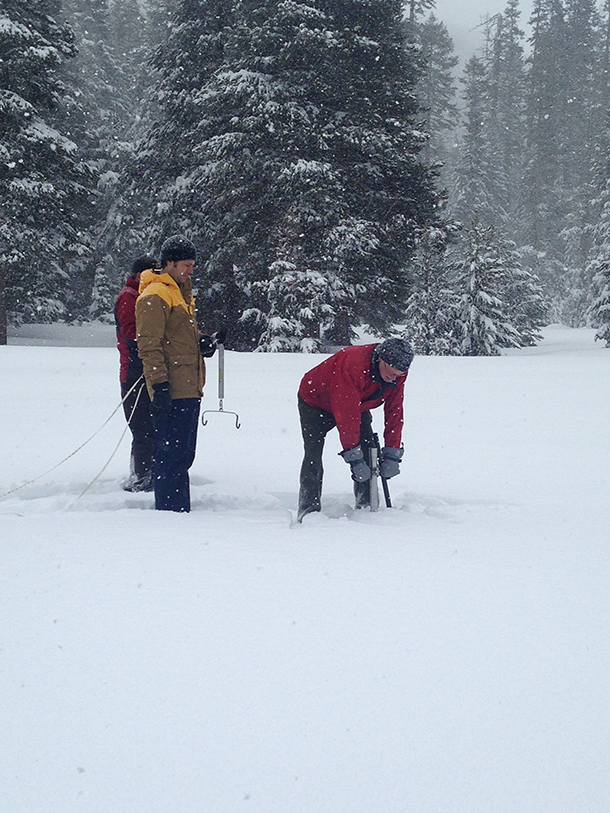
Frank Gehrke plunges his tube into the snow pack. (Photo: Emmett FitzGerald)
GEHRKE: So after all of that sampling we had a water content of 25.4 inches and that represents 130 percent of its average since 1966.
FITZGERALD: That’s 130% of the average snowpack on this day in history. Now that’s just at this one location. On the day, the snow pack across the state is lower then where we are right now, but still above average, and Gehrke is pleased.
GEHRKE: I think it’s very encouraging. It’s a really good start. We do need much better than just average, and we’re getting it now, hopefully we really increase that percent of average as we move on into the spring.
FITZGERALD: The most important test will come in April, when scientists tally up the total snow accumulation for the winter. Last April, California governor Jerry Brown came to Philips Station for the year’s final snowpack assessment. But there wasn’t any snow. Pictures of the governor standing there next to Frank on the bare grass became iconic images of the California drought. It was the worst snow year in Frank’s career. But 7 of the last ten years have had below average snowpack, and Frank says that’s a huge problem because snow in the mountains provides California with water throughout the year.
GEHRKE: The snowpack is sort of the natural reservoir. The snow accumulates up here in the Sierra during the winter and then gradually melts when we hit late spring. And if we don’t have a good snowpack than those reservoirs do not essentially recover from the releases they had made the previous summer and fall.

Examining the extruded snow core. (Photo: Emmett FitzGerald)
[ROAD NOISE, TRAFFIC]
FITZGERALD: Back down from the mountains in sunny downtown Oakland, I stop by the Pacific Institute, a global water think tank. Peter Gleick is the director, and he says two good months of snow is an encouraging start to the winter.
GLEICK: But it says nothing about what the next couple of months are going to bring. Our wet season runs through April.
FITZGERALD: And a lot could change between now and then. In February of 2013 the Sierra snowpack was about where it is right now, but the next two months were bone dry, and snow levels ended up well below average for the year.
GLEICK: We don’t really know what’s going to happen in the next couple of months. It is an el Niño year, but el Niños can be wet for Northern California or they can be dry for Northern California. So it’s a little bit of a toss of the dice still.
Frank Gehrke measures the snow pack. (Credit: Emmett FitzGerald)
FITZGERALD: As if to illustrate that point, the week following the snowpack assessment was dry and hot, with record high temperatures throughout the State. As of recording this, the statewide snowpack has fallen to just 104% of average. Warm weather in February can also cause snow to melt earlier than usual, which is a problem for reservoir operators.
GLEICK: If it melts now, early in the season, we can capture some of it in the reservoirs, but we can’t capture it all because we have to have reserve space in our reservoirs for future storms in order to protect the state against flooding.
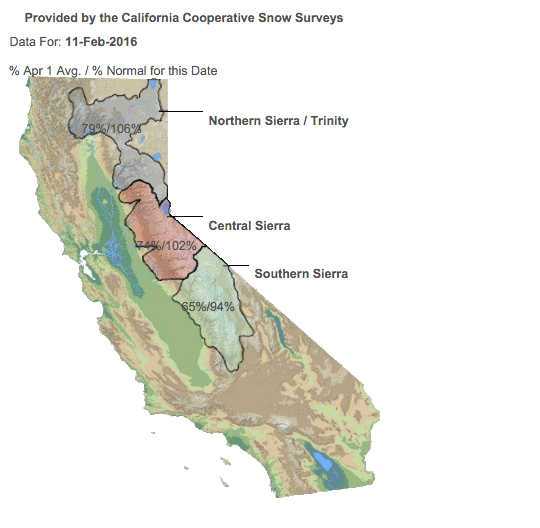
Snowpack percentages for February 11, 2016 compared to the average on that day. (Photo: California Department of Water Resources)
FITZGERALD: So a lot of that water content is lost. No matter what the weather brings between now and April, Peter says Californians shouldn’t be thinking that el Niño is going to pull the state out of drought.
GLEICK: Even if it’s a wet year in California, that by itself is not enough to get us out of the drought. Our reservoirs are still really low, our soil moisture is low, our groundwater is over-drafted. We’re in a deeper hole than one year is going to fill.
FITZGERALD: And State officials agree. Despite the snow, the California Water Resources Control Board recently decided to extend Governor Jerry Brown’s emergency water restrictions through October of 2016. Max Gomberg is the Climate and Conservation Manager for the control board based in the state capital, Sacramento. He says, since the governor announced the water restrictions last April, Californians in urban areas have cut their water use by 25%.
GOMBERG: It’s really a tremendous achievement. It shows that people are paying attention and care for this precious resource. Because 25% that’s one in every 4 drops of water that was used is no longer being used.
FITZGERALD: And water conservation is only going to get more important in the future. Max says that drought is a natural part of the climate in California, but climate change is making it more common and more severe.
GOMBERG: And the drought in the past 4 years in California has been so severe you know we’ve lost 22 million trees, we’ve had a tremendous number of forest fires, communities have run out of water, we’ve lost 97% of some of our fish species. The impacts have really been devastating.
FITZGERALD: Peter Gleick of the Pacific Institute says with warming temperatures and increased demands on the water supply, California may never really “get out” of the drought.
GLEICK: In a sense a drought is not having enough water to do what you want. And in that sense the Western United States one could argue is in a permanent drought. We no longer have enough water to do everything that everybody wants, at least as inefficiently as we’re doing it today. Look, if we end April with 140% of normal snowpack that would be great, but we have permanent water problems in California and in the West.
FITZGERALD: And they require permanent solutions. Peter says it’s great that the state is asking people to stop watering their lawns, and shorten their showers, but those measures are temporary, behavioral changes.
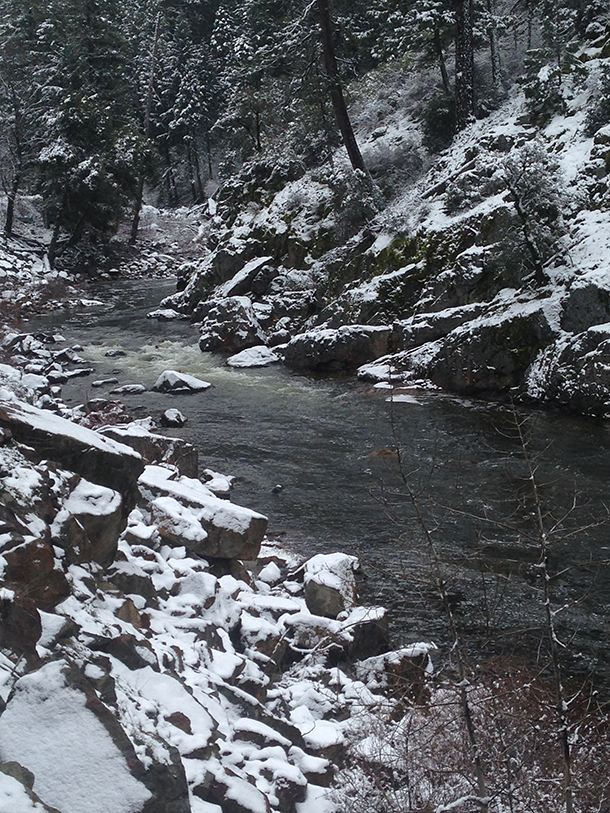
A nearby Sierra Mountain stream (Photo: Emmett FitzGerald)
GLEICK: I do think the state should be doing more in terms of permanent improvements in efficiency. We should be providing farmers with financial incentives to move to more efficient irrigation systems or to grow more efficient crops. We should be providing incentives for our cities to find and fix leaks, to replace inefficient washing machines and toilets and showerheads.
FITZGERALD: Increasing efficiency might seem like a small step, but it’s the best way to reduce the State’s overall water use.
GLEICK We could cut our water-use in cities by 20 or 30 percent without affecting our quality of lives. We could cut water use 15 or 20 percent in agriculture without cutting the amount of food we grow.
FITZGERALD: And Peter Gleick says we should also be getting creative and taking advantage of new supply options, like treated wastewater.
GLEICK: That stuff’s not a liability, that stuff’s an asset. And increasingly water districts are exploring ways of putting that high-quality treated wastewater to use. We’re using it on landscaping here. We’re using it for cooling power plants, we using it for all sorts of industrial processes.
FITZGERALD: These sorts of changes aren’t glamorous. But if California is going to survive and grow in the changing climate, they're exactly what’s needed.
For Living on Earth this is Emmett FitzGerald in Oakland, California.
Related links:
- Stay up to date on the state of the California snowpack
- Pacific Institute
- Impact of Climate Change on Snowpack
- Can El Niño Snows Alleviate Drought?
Sex and Sustainability in the Sea

Sex in the Sea: Our Intimate Connection with Sex-changing Fish, Romantic Lobsters, Kinky Squid and Other Salty Erotica of the Deep is Marah Hardt’s first book. (Photo: courtesy of Marah Hardt)
CURWOOD: The fate of the oceans and fisheries are a topic we often cover here at Living on Earth. Today we have another take on the subject, from author and coral reef ecologist Marah Hardt, co-director of the non-profit Future of Fish, which works to create a global business model for responsible fishing. And for this week of Valentine’s Day, she joins us from a sustainable seafood conference in Malta to discuss her new book, and give us her salty take on what happens below the ocean surface. Marah, welcome to Living on Earth.
HARDT: Hi there, thanks for having me!
CURWOOD: And before we do anything else, please read a passage from your book page 166.
HARDT: I would love to.
Her skin shone in the moonlight, a flash of silver against a dark beach. She knew he wanted her. She could see him desperately fighting his way toward her from amongst the crowd. She positioned herself perfectly, knowing the sight of her bound body restrained and prostrate in the sand would make him, would make all of them quiver with excitement. The first to reach her, he feverishly curled himself around her. Others soon joined him, forming their own half-circle embraces. This is what she came here for, what they had all come for.
CURWOOD: Whew! This sounds kind of hot, Marah, but I guess we need to tell people this not the beginning of your latest romance novel, although it sounds like you have a flair for that sort of thing because you're talking about your new book Sex in the Sea where you document various mating rituals and courtship tactics, the sexcapades, they sound foreign but they, in some respects, mirror our own experience as humans. And this passage that you just read us, you're describing, what, this is the shore orgy of the grunion?
HARDT: Of the grunion, yes, so these are small silver fish that can fit in the palm of your hand, and they come to shore every spring to do as you said a mass orgy on the beach. It's their strategy for reproduction and it's a really fun spectacle that folks can go down and watch anywhere along the Southern California shores into Mexico.
CURWOOD: So, as a marine biologist I guess who has this dual career, what compelled you to write this book in this creative writing style you've chosen?
HARDT: So I was at a cocktail party, I was talking to some friends. We were having one of those conversations where we were lamenting not understanding the opposite sex, so folks were saying, “Gosh, if just for one day I could be in the body of a guy just know how they think or what's going through their head”, and I made very casually this off-comment that, "I know if only we could be parrot fish." It was like you could here a needle drop. I was met with these dropped jaws and open big wide eyes and everybody said, what are you talking about? So I said, "Oh, well, you know, parrot fish, they can change sex. They start life as female and transition into males." So, I explain this a little further how this is a really common strategy for reproduction in the ocean.
People were still listening, they were still really curious, and I said, "well, you know, if you think about it, that makes things really complicated for management because we tend to like to catch the biggest fish and if you think about it, if you're catching all the big ones, you're catching all the males. So you might be leaving enough fish in the sea, but if they're all females, your reproduction is going to slow down." And it was about 20 minutes later I was refilling my wine glass and I heard someone who I had been talking to say to somebody else at the party, "did you know fish change sex? Isn't that bizarre?" And I thought -- that's it. If you talk about sex, people are curious and maybe there's a way you can talk about sex, draw their attention and then subtly weave in the message of conservation because ultimately successful sex is part of sustainability.
CURWOOD: So talk to me about the various dating games of the deep.
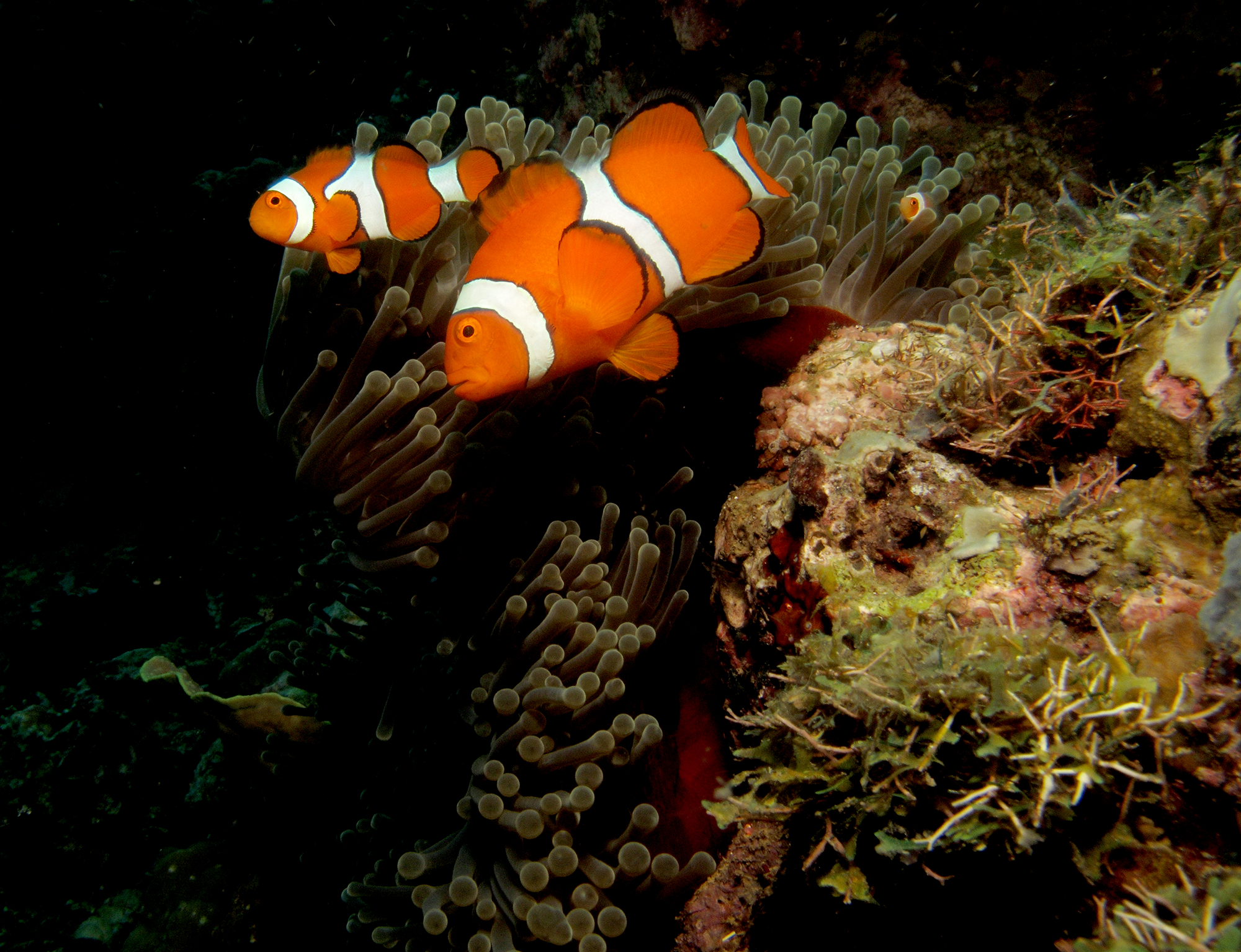
Clownfish, which mostly form in monogamous pairs, can change sex from male to female. (Photo: courtesy of Marah Hardt)
HARDT: So first, there's the search, which is how species have to find one another which in the ocean is a huge challenge. It's the largest living space on the planet, 99 percent of where animals can live is in the ocean. So, you imagine it's hard to find one another. So, that's the first challenge, and animals do this in all sorts of different ways, one of which is to do very much like what we do, which is to go to the equivalent of a singles bar or a hotspot for sex. Nassau Grouper, great example, they will travel down along the reefs. They normally live solitary lives, and they don't tend to interact with each other very much. But right after the full moon, they will move to the edge of the reef and wait and see when other groupers start passing by and they gather at the same spot every year, at the same time, they will shift their coloration and change from some desert camo pattern which is very good for ambush predators to kind of jump out on a reef and get prey and they switch more into to this black-tie affair where they'll go into a dark black mode or black with a white belly and these colors sort of signal that they're ready to be friendly and they're ready to engage more intimately and then they form these giant beautiful swirling balls and right at dusk, as soon as that light starts to change, you can see they kind of get a little fired up, they get a little antsy.
And very soon after that females are, they look pregnant, they're swollen with eggs and a female will rocket out from the group and she'll shoot towards the surface and the males will follow her and sort of form this funnel moving upwards in the water column. She releases her eggs about 10 to 20 feet below the surface and then males will streak through this cloud of eggs that she's released and they'll release their sperm. These milky clouds form and the fish sort of tumble back down in this cascading sort of geyser of fish that erupts and then falls to the sea floor and they'll move up a little bit up the reef, and do the same thing again. So you get these repeated, it's almost like Old Faithful full of fish just shoot up, explode.
CURWOOD: [LAUGHS] Fish geysers.
HARDT: Yes, fish geysers, and the visibility will go from 100 feet to where you can't even see in front of your face.
CURWOOD: So this is if they sort of they're Nassau Grouper, they're found off Bermuda?
HARDT: They're found all throughout the Caribbean, but unfortunately these days it's really hard to find them. They follow the same cues every year. In order for the fish to find one another, makes it very easy for fishers to find them, and you have all of the biggest fish clumping together all at the same time and a very predictable schedule every year it's very easy to overfish them, and so we've seen this happen again and again and again where these spawning aggregations really just get hammered.
CURWOOD: And this phenomenon, of course, allows people who fish to say, well, there are plenty of fish because they go to these aggregations.
HARDT: It looks, yeah and the abundances look absolutely huge. You can have the entire breeding population of one island in one location in one aggregation. So if you wipe that out, they're not coming in from anywhere else and it's really not until you have only a few dozen left that you realize there's no more coming anymore and that's it.
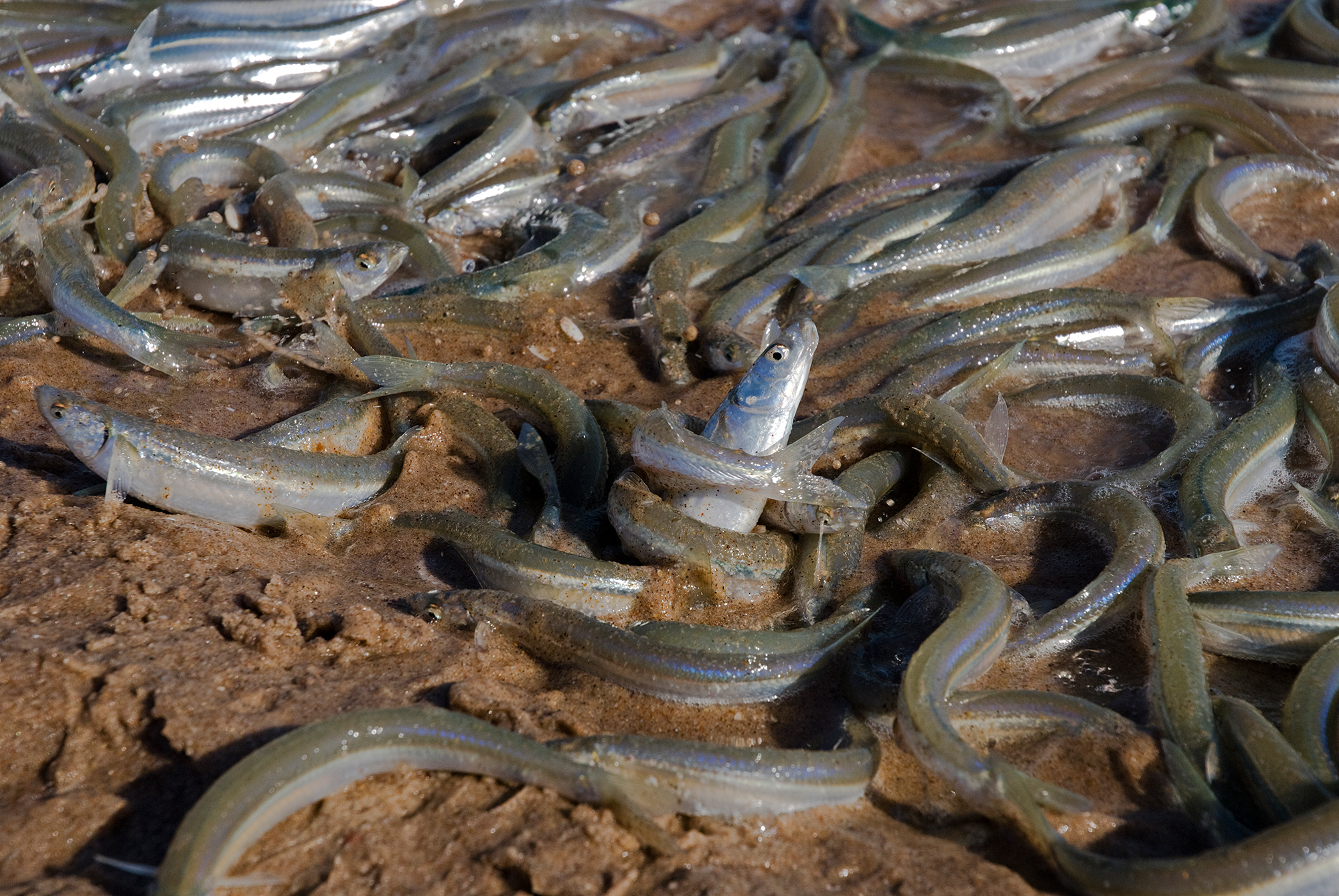
Grunion are small silver fish that come ashore every spring to mate on the beaches of Southern California. (Photo: courtesy of Marah Hardt)
CURWOOD: That’s Marah Hardt, author of the book Sex in the Sea and we’ll have more of our conversation just ahead on Living on Earth. So stay tuned.
[MUSIC: Louis Armstrong, Let's Fall In Love, on "Ella and Louis Again" by Cole Porter, Verve Records]
ANNOUNCER: Funding for Living on Earth comes from United Technologies, a provider to the aerospace and building systems industries worldwide. UTC Building & Industrial Systems, provide building technologies and supplies container refrigeration systems that transport and preserve food and medicine with brands such as Otis, Carrier, Chubb, Edwards and Kidde. This is PRI, Public Radio International.
[CUTAWAY MUSIC: New York Philharmonic/Leonard Bernstein (Aaron Copland), Quiet City, Copland: Symphony No.3/ Quiet City, by Aaron Copland Deutsche Grammophon]
CURWOOD: It's Living on Earth, I'm Steve Curwood. We continue now with ecologist Marah Hardt, talking about her new book Sex in the Sea. I asked her about her own specialty, coral reefs.
HARDT: Well, corals are these fantastic animals. They look like little anemones that are trapped in a cup, and they build these little cup houses and those houses then stitch together into apartment buildings and are then stitched together into big city blocks and then build reefs so big we can see them from space.
CURWOOD: They're the only creature we can see from space.
HARDT: Yeah, I think so. Yeah, I believe that's true, the only ones that build living structures large enough to see from space. But because they build these reefs, they're stuck. They can't move to produce. So they reproduce more like what would be almost like a plant system. They release their eggs and sperm into the water column, but the way that they do this is fantastic because you're talking about an animal that has, from our understanding, a pretty basic body plan, no big higher brain at work here and yet they organize truly the biggest orgy on the planet and it's perfectly synchronized. You can set your watch to it and in fact, researchers do every year, and it's like all of a sudden, the underwater world turns into a snowstorm, only the snowflakes rise up and are bright pink. So, the corals sit at the bottom of the sea and they release these bundles that are this bright pink coral color, and the bundles are the egg and sperm because most of the big corals that make the big reefs are hermaphrodites. And these bundles float up through the dark water column and then explode at the surface, releasing the egg and sperm and creating this giant slick of coral gametes, the term for eggs and sperm, and it all mixes and mashes at the top, and that's how you get sperm from one individual to mix with an egg of another.
CURWOOD: Except you said that when you observed this, well, that there was something really familiar about it.

Nassau Grouper spawning. They are still found throughout the Caribbean, but their numbers are greatly diminished from overfishing. (Photo: courtesy of Marah Hardt)
HARDT: [LAUGHS] There was. So this was one of my more semi-embarrassing moments because it happened very early my grad school career. You watch the event, you come up to the surface and you come up through again this slick of coral goo and it smells very potent and very familiar of other types of sexual activity that you can sense in other animals including our own species. [LAUGHS] It's a little bit funky, and there is sort of this unspoken initiation among people who study coral sex who always look at each other and think,“Oh my gosh, this is so weird!”
CURWOOD: So talk to me about the various dating games of the deep. Now why in nature is seduction necessary?
HARDT: Well, think about the resources it takes to produce an offspring. So, females in particular have to go through a lot of energy to produce these eggs and, in many cases to raise the young, care for the young for a little while. So they want to be discerning, they want to ensure that they are making an offspring with a male counterpart who has good genes.
CURWOOD: I have to say that you have a wonderful section about lobster dating, mating and sex.
HARDT: [LAUGHS] Mmmm, lobsters are so romantic.
CURWOOD: Yeah, I had no idea.
HARDT: I know! I didn't either. What happens with lobsters...it starts off a little kinky and then it gets romantic, so bare with me, I promise we'll get to the romance. Around mating season is very aggressive. The biggest males they fight and the largest males gain dominance over the best dens. They go and kind of harass their neighbors, and they literally pee in the front door of their neighbor’s dens [LAUGHS] and it's quite rude. It's literally just to show that he can.
CURWOOD: This is like the movie "Grease" where these guys from the other group show up in their big car and they say your car is dented and broken and then after they kick it a few times, put in a few more dents, then they roar off.
HARDT: Exactly and so this is all fine and good. It helps the females identify who's the biggest and strongest, which again for her is a good thing because that's going to be good for her offspring. However, the best time for both females and males to mate is when the female molts because female lobsters have this very neat trick whereby they can lose and regain their virginity. So a female lobster has a pouch underneath her tail where she stores sperm from a male. What this means is right after she molts, she gets a new empty pouch. If she can mate right away, she feels that pouch full and then has more time to fertilize multiple batches before she grows too much and has to molt again. For the male, finding a female who has an empty pouch means he can pour all of his sperm into it and he doesn't have to share that pouch with other male sperm, so that's an advantage for him. However, for the female, when she molts, she is a soft-bodied animal, she can't even stand for the first half and hour. She is extremely vulnerable to being preyed upon or just killed.
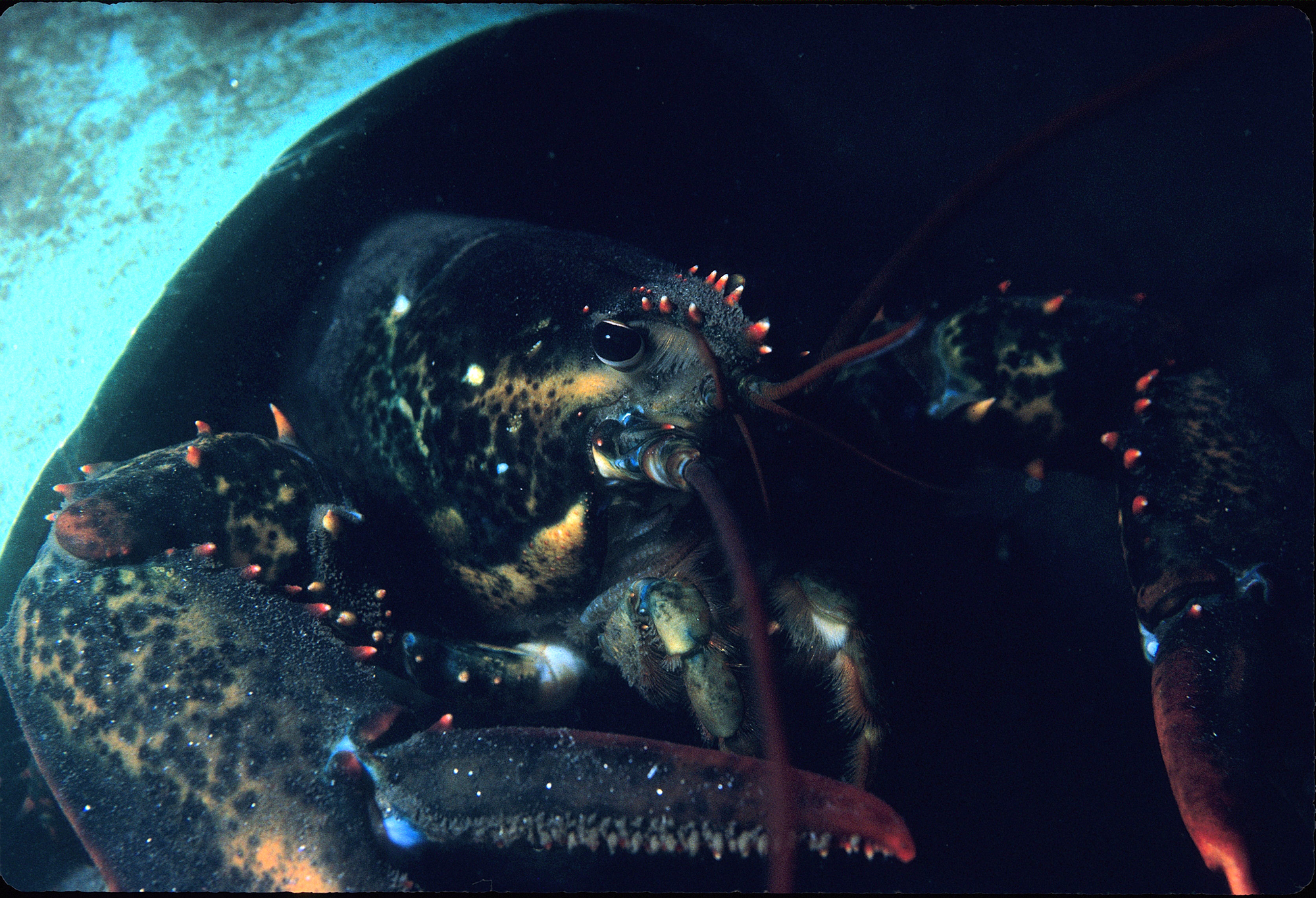
When it is time for her to molt, a female lobster seeks out a strong male, not only to fertilize her eggs, but also to protect her when her body is soft and vulnerable to predators. (Photo: courtesy of Marah Hardt)
So what she does, she comes up with a love potion to seduce this male, and basically entrance him into becoming very gentle lover, and she does this by peeing in his face. So, she creates a stream of urine and every day will go up to his den, and spray a little bit of urine in and then she'll run away before he has a chance to be aggressive. She does this for about a week, daily little spritzes in his face, into his den. And after about a week it starts to sort of take hold. He starts to realize, oh this is a female, this is ripe female, this female is ready to do something that I think I would like to engage in. When she starts to sense that her potion has taken hold, she will move in with him and for about another week they will cohabitate, they will live together, She will go hunt, he will go hunt. And then this moment comes where she can feel that her molt is about to happen and she will walk out in front of him and do what Professor Jelle Atema calls“the knighting process”. So the female walks out and turns face-to-face with the male. And -- I should've explained lobsters, their bladders sit below their brains just behind their eyes so when they spray urine it comes out of these nozzles that are located right on their face under their eyeballs. [LAUGHTER] By coming face-to-face with her mate she can spray him most effectively and directly. She sprays him with copious amounts of urine. He sprays her back.
CURWOOD: This is an amazing golden shower.
HARDT: It is a 100 percent a golden shower. And he puts his claws down and kind of lowers his head. His big front claws go down into the sand. She lifts yourself up on her walking legs and takes one of her claws and taps him once on one shoulder and then across to the other shoulder. It really is like a knighting process and Dr. Atema says it's pretty clear the signal is don't go away, I'm about to molt, it's time to get busy. And it takes a few hours for the molting process to complete. She kind of slips out of her shell. She, again, can't stand at this point. The male all the while will sort of be near her, sometimes he will run his antennae over hers, sort of stroking her, he will tickle her, like light touches with his walking legs, just checking in on her. And again, from the female's perspective, this whole courtship process has brought her to a point where she now has the biggest toughest male not only to fertilize her eggs, but to protect her in the stage where she is so vulnerable.
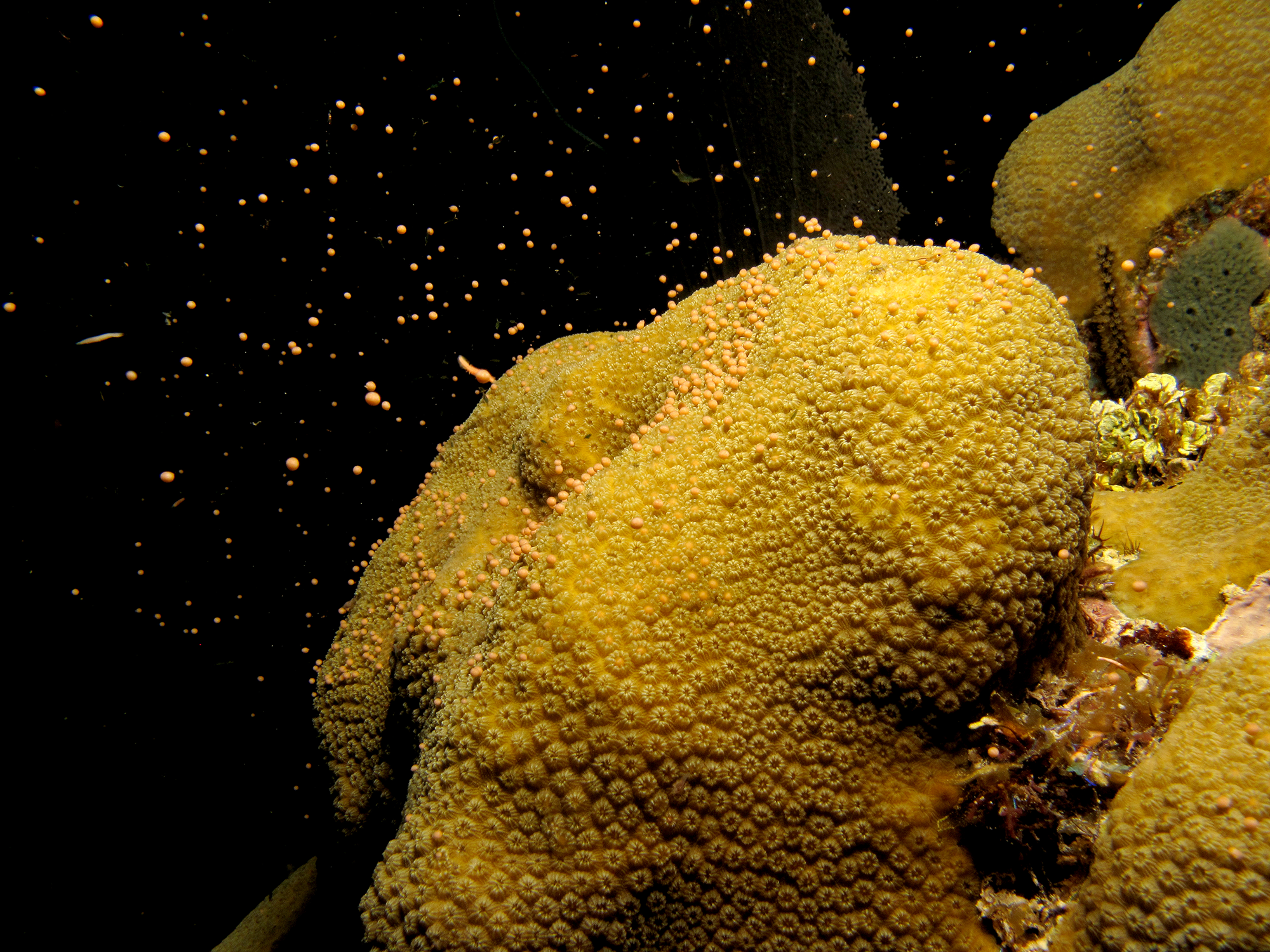
M. annularis coral spawn. Most corals, including M. annularis, are hermaphrodites and release both eggs and sperm that mix on the ocean surface. (Photo: courtesy of Marah Hardt)
CURWOOD: So the oceans are changing Marah, there's pollution like a lot more nitrogen, temperature regimes are changing, climate change. How is this affecting the sex underneath the waves?
HARDT: Well in many ways...for example the lobsters that we were speaking about, they have this very elaborate chemical communication, right, through their pee, and that requires them to be able to smell with very accurate senses, very heightened senses to smelling, and when we put pollutants in the water it can mask those chemical signals so that they can't necessarily sense what the signal is, and imagine if you're that female and you're spraying this pee and you think your potion is taking effect and then find out that the male couldn't smell you when you approach him, it's not to be a pretty situation right.
The other thing is things like ocean acidification, which is another byproduct of climate change in the ocean where we're actually changing the pH of the water, the acidity. All of the little sensors in the antenna, and antennules, they're highly sensitive to chemistry and they may be damaged or they may be reduced in their capacity in a more acidic ocean or it could be that the signals that are being produced, the way that the actual molecules in the urine react with seawater will change based on the acidity. It's as if for centuries lobsters have been writing in English to one another through their pee, but then all of a sudden with ocean acidification the letters are getting scrambled, and a male is receiving a message that he can no longer understand or read.
CURWOOD: Talk to me about the whales. Now there will probably be a giggle from some listening to us because they know that whales can have humongous organs, but I'm thinking about whales, Right whales having, well, kind of group sex.
HARDT: Yes, so looking at the anatomy of an animal can tell you a lot about the way that animal reproduces, in particular whether they tend to have many partners or not. Now, in the Right whale, they're not the biggest whale. They do not have the biggest penis, but they do have the biggest testicles on Earth. Each testes weights half a ton.
CURWOOD: That's some cojones, I would say.
HARDT: These are some serious cojones, yes. What it tells us is that it is likely that these males are having to compete with other males internal to the female. So, when we see males with these very large packages, it tends to mean that they are dumping copious amounts of sperm into that female and the reason to do that is to try to flush out the sperm of other males that may be in there or to push their fellas as far as they can. And we knew that lots of group sex was happening. But there's this fantastic - I believe they caught it on video, but there's definitely wonderful photos - where a bunch of research scientists were in their boats. They were there tagging whales and somebody saw a female come up to the surface and roll onto her back and a researcher named Dr. Phillip Clapham who is with NOAA, the National Ocean and Atmospheric Administration, tells it that it wasn't that uncommon, that you would see a female come up and roll and then a male giant pink phallus comes out of the water and will enter into her, but what happened this time was one male came up on one side and they all saw, someone yelled out, “Penis, insertion is happening everyone.” And then somebody went, "Holy smokes there's another one!" And they turn around and it's like two giant bowed penises, and these things are like six feet long. I mean they are big phalluses coming up, arching out of the water and entering into the female simultaneously. So always knew that Right whales were frisky and that there was some sperm competition going on, but if anything is going to encourage the production of gigantic testes it's going to be having to ejaculate at the same time as another male is in the female at once.
CURWOOD: It gives new meaning to the phrase "a whale of a time".

Male right whales have the largest testes of any creature on Earth. (Photo: robdownunder, Flickr CC BY-NC-ND 2.0)
HARDT: Oh my goodness yes! [LAUGHS]
CURWOOD: So this brings us to one of the most scientifically provocative parts of your book and that is probing the scientific mysteries of the vagina. This part of the anatomy which given that guys are guys tend to pay attention to what you can see rather than what you can't see.
HARDT: This is true and it's wonderful because we're at point now where there is growing recognition of the importance of the female body and anatomy and behavior in influencing the outcome of reproduction. For a long time, females were thought of as sort of the passive receivers of sperm and that was really it, especially once sex had happened. So, for internal fertilizers it was thought that once the male gained access to the female and deposited his sperm, again there might be some sperm competition going on but the female really had no control, and a researcher named Dr. Sarah Mesnick who works out of the Southwest Fisheries Science Center in San Diego has been made a fantastic mentor in walking me through this marvelous world of whale vaginas in particular.
What they found is rather than thinking of a whale vagina as a single tube leading into a uterus, it's actually like a maze. They find twist and turns and blind alleys and false flaps and trapdoors and I remember Sarah saying to me, "When we first looked in this thing, all I could think of was how the heck does a sperm find his way to the cervix? How do they even know where to go?" Again, like Sarah says, that "last mile", it's female territory, it's their home turf so they're controlling a lot more than we realized.
CURWOOD: Talk to me about sex change. You say that fish like the Gobi and clown fish can go both ways.
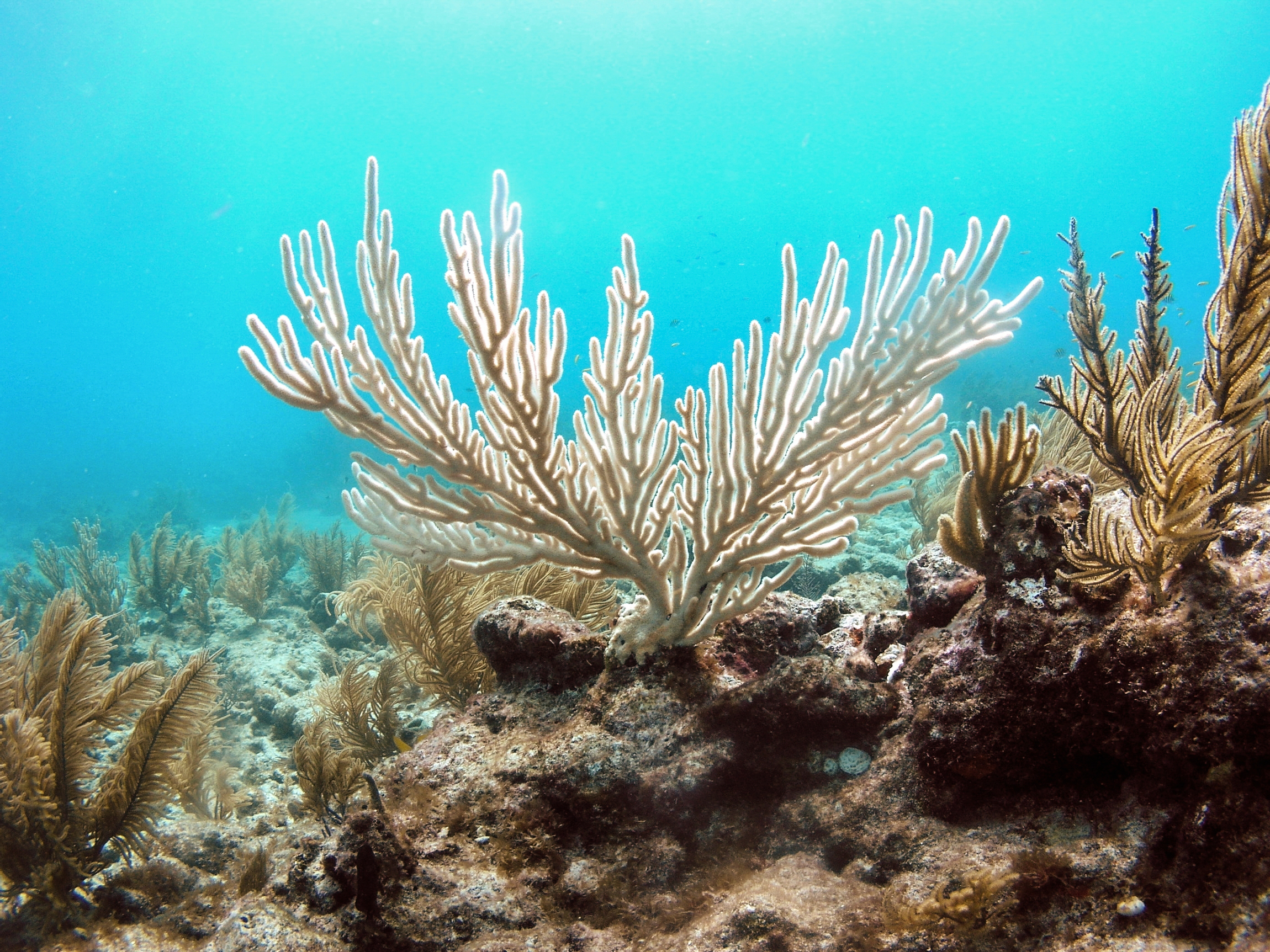
As Earth’s oceans become more polluted and acidic, sea creatures have a harder time sensing their mates and successfully reproducing. (Photo: Kelsey Roberts/U.S. Geological Survey, Flickr CC0 1.0)
HARDT: Yeah, so sex change is a really common strategy in the ocean, oysters do it, shrimp do it, many, many different fish do it. And what does, is it works really well to help maximize the amount of babies you can make. So in systems where males can dominate females, but they need to be big to do so, it makes sense when you're small and a little bit less aggressive to be a female, you can reproduce as a female, and then once you've grown big and strong and gain some ability to be a dominant male, you switch into to that male role and you can take over a harem, and you can defend a territory, and then you can meet with tons of females and keep your reproductive efforts at a max. In other systems it makes sense to actually go the opposite direction. So, for example, for some species like a clown fish, who get together and stay in relatively monogamous pairs inside their little anemone home - there's a male and a female - it makes sense that you would want to start as a male, hook up with a big female, you're a small male, you can still mate. But then when your bigger female passes on, you can take on the big role, grow into being a large female and take a smaller male along with you. A smaller male has enough sperm to fertilize all the eggs a big female can produce.
What's really crazy when you think about is I don't think any of us would choose to go through puberty twice, right?
[LAUGHTER]
I mean, let's not do that. But for these fish it's really effective, it's also again really important for management because when you have a sex changing species you have to be managing not only the number of fish that are there, you have to make sure you're monitoring the sex ratio and when we start pulling these fish out, we're triggering them to change sex perhaps when they might not otherwise, and this could have huge consequences for the amount of reproduction and the success of reproduction.
CURWOOD: Marah, before you go, if you were to come back as a sea creature, based on your studies of underwater erotica, which creature would you choose to be?
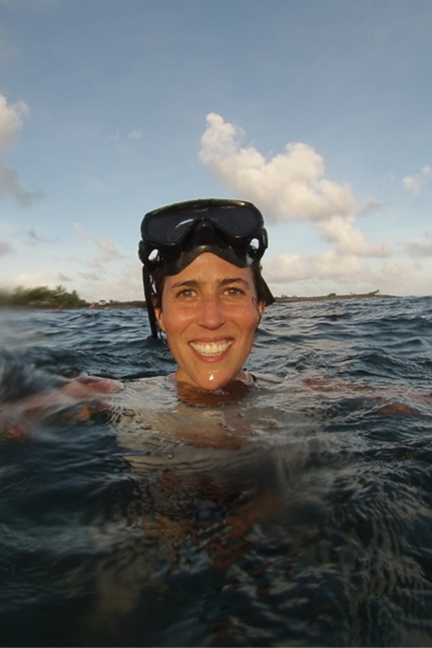
Marah Hardt is a marine biologist, author and research scientist working towards solutions for ocean conservation. (Photo: Joe Laughlin)
HARDT: [LAUGHS] Man, that is such a loaded question. Who would I be? I think that the corals really create a magical spectacle. Coral sex is almost like being a musician who gets to play in this incredible orchestra, and all year long you're practicing your part, right, you're the violinist, or the cellist, and you're practicing your part and just making sure that you have every note perfect and everything is ready to go and then you have this one grand night under the full moon in the tropics and you all come together and you play the piece and it crescendos and everything takes off at once. To me that that would be a pretty cool, yeah, a very cool way to reproduce and send off the next generation in this beautiful ethereal group activity that requires a lot of coordination, but you don't have to get too dirty, too messy.
CURWOOD: So once a year with passion! [LAUGHS]
HARDT: Once a year with passion and then everyone leaves you alone, you can go back to doing what you want to do!
CURWOOD: Marah Hardt's new book is called Sex in the Sea: Our Intimate Connection with Sex-changing Fish, Romantic Lobsters, Kinky Squid and Other Salty Erotica of the Deep. Thank you so much Dr. Hardt taking the time with us today.
HARDT: Oh, thank you so much for having me. This was a pleasure.
Related links:
- Marah Hardt’s book Sex in the Sea
- About Marah Hardt
- Sex at Nearly 10,000 Feet Below Ocean's Surface
- 6 Freaky Sex Tips From Sea Creatures
[MUSIC: Louis Armstrong, Let's Fall In Love, on "Ella and Louis Again" by Cole Porter, Verve Records]
CURWOOD: Next time on Living on Earth...a meteorologist applies weather patterns to the grid to help distribute renewable power.
MCDONALD: If we want to preserve the future, this gives us an option to have low-carbon and low-cost energy economy and we think that’s a pretty valuable possibility.
CURWOOD: What the weather can teach us about a more resilient energy future.
[MUSIC: Sultans Of String with Anwar Khurshid, Enter the Gate, Subcontinental Drift MCK Records ]
CURWOOD: Living on Earth is produced by the World Media Foundation. Our crew includes Naomi Arenberg, Bobby Bascomb, Emmett Fitzgerald, Lauren Hinkel, Helen Palmer, Adelaide Chen, Jenni Doering, Peter Boucher, Jaime Kaiser John Duff, Amber Rodriguez and Jennifer Marquis. Tom Tiger engineered our show, with help from Jeff Wade, Jake Rego and Noel Flatt. Alison Lirish Dean composed our themes. You can find us anytime at LOE.org - and like us on our Facebook page - it’s PRI’s Living on Earth. And we tweet from @LivingOnEarth. I'm Steve Curwood. Thanks for listening.
ANNOUNCER1: Funding for Living on Earth comes you, our listeners, and from the University of Massachusetts Boston, in association with its School for the Environment, developing the next generation of environmental leaders. And from the Grantham Foundation for the protection of the environment, supporting strategic communications and collaboration in solving the world’s most pressing environmental problems. And Gilman Ordway for coverage of conservation and environmental change. And from Solar city, America’s solar power provider. Solar city is dedicated to revolutionizing the way energy is delivered by giving customers a renewable alternative to fossil fuels. Information at 888-997-1703. That’s 888-997-1703.
ANNOUNCER2: This is PRI. Public Radio International.
Living on Earth wants to hear from you!
Living on Earth
62 Calef Highway, Suite 212
Lee, NH 03861
Telephone: 617-287-4121
E-mail: comments@loe.org
Newsletter [Click here]
Donate to Living on Earth!
Living on Earth is an independent media program and relies entirely on contributions from listeners and institutions supporting public service. Please donate now to preserve an independent environmental voice.
NewsletterLiving on Earth offers a weekly delivery of the show's rundown to your mailbox. Sign up for our newsletter today!
 Sailors For The Sea: Be the change you want to sea.
Sailors For The Sea: Be the change you want to sea.
 The Grantham Foundation for the Protection of the Environment: Committed to protecting and improving the health of the global environment.
The Grantham Foundation for the Protection of the Environment: Committed to protecting and improving the health of the global environment.
 Contribute to Living on Earth and receive, as our gift to you, an archival print of one of Mark Seth Lender's extraordinary wildlife photographs. Follow the link to see Mark's current collection of photographs.
Contribute to Living on Earth and receive, as our gift to you, an archival print of one of Mark Seth Lender's extraordinary wildlife photographs. Follow the link to see Mark's current collection of photographs.
 Buy a signed copy of Mark Seth Lender's book Smeagull the Seagull & support Living on Earth
Buy a signed copy of Mark Seth Lender's book Smeagull the Seagull & support Living on Earth

